Dan Zeng
PoRe: Position-Reweighted Visual Token Pruning for Vision Language Models
Aug 25, 2025Abstract:Vision-Language Models (VLMs) typically process a significantly larger number of visual tokens compared to text tokens due to the inherent redundancy in visual signals. Visual token pruning is a promising direction to reduce the computational cost of VLMs by eliminating redundant visual tokens. The text-visual attention score is a widely adopted criterion for visual token pruning as it reflects the relevance of visual tokens to the text input. However, many sequence models exhibit a recency bias, where tokens appearing later in the sequence exert a disproportionately large influence on the model's output. In VLMs, this bias manifests as inflated attention scores for tokens corresponding to the lower regions of the image, leading to suboptimal pruning that disproportionately retains tokens from the image bottom. In this paper, we present an extremely simple yet effective approach to alleviate the recency bias in visual token pruning. We propose a straightforward reweighting mechanism that adjusts the attention scores of visual tokens according to their spatial positions in the image. Our method, termed Position-reweighted Visual Token Pruning, is a plug-and-play solution that can be seamlessly incorporated into existing visual token pruning frameworks without any changes to the model architecture or extra training. Extensive experiments on LVLMs demonstrate that our method improves the performance of visual token pruning with minimal computational overhead.
SMTrack: End-to-End Trained Spiking Neural Networks for Multi-Object Tracking in RGB Videos
Aug 20, 2025Abstract:Brain-inspired Spiking Neural Networks (SNNs) exhibit significant potential for low-power computation, yet their application in visual tasks remains largely confined to image classification, object detection, and event-based tracking. In contrast, real-world vision systems still widely use conventional RGB video streams, where the potential of directly-trained SNNs for complex temporal tasks such as multi-object tracking (MOT) remains underexplored. To address this challenge, we propose SMTrack-the first directly trained deep SNN framework for end-to-end multi-object tracking on standard RGB videos. SMTrack introduces an adaptive and scale-aware Normalized Wasserstein Distance loss (Asa-NWDLoss) to improve detection and localization performance under varying object scales and densities. Specifically, the method computes the average object size within each training batch and dynamically adjusts the normalization factor, thereby enhancing sensitivity to small objects. For the association stage, we incorporate the TrackTrack identity module to maintain robust and consistent object trajectories. Extensive evaluations on BEE24, MOT17, MOT20, and DanceTrack show that SMTrack achieves performance on par with leading ANN-based MOT methods, advancing robust and accurate SNN-based tracking in complex scenarios.
Learning Occlusion-Robust Vision Transformers for Real-Time UAV Tracking
Apr 12, 2025Abstract:Single-stream architectures using Vision Transformer (ViT) backbones show great potential for real-time UAV tracking recently. However, frequent occlusions from obstacles like buildings and trees expose a major drawback: these models often lack strategies to handle occlusions effectively. New methods are needed to enhance the occlusion resilience of single-stream ViT models in aerial tracking. In this work, we propose to learn Occlusion-Robust Representations (ORR) based on ViTs for UAV tracking by enforcing an invariance of the feature representation of a target with respect to random masking operations modeled by a spatial Cox process. Hopefully, this random masking approximately simulates target occlusions, thereby enabling us to learn ViTs that are robust to target occlusion for UAV tracking. This framework is termed ORTrack. Additionally, to facilitate real-time applications, we propose an Adaptive Feature-Based Knowledge Distillation (AFKD) method to create a more compact tracker, which adaptively mimics the behavior of the teacher model ORTrack according to the task's difficulty. This student model, dubbed ORTrack-D, retains much of ORTrack's performance while offering higher efficiency. Extensive experiments on multiple benchmarks validate the effectiveness of our method, demonstrating its state-of-the-art performance. Codes is available at https://github.com/wuyou3474/ORTrack.
3CAD: A Large-Scale Real-World 3C Product Dataset for Unsupervised Anomaly
Feb 09, 2025



Abstract:Industrial anomaly detection achieves progress thanks to datasets such as MVTec-AD and VisA. However, they suf- fer from limitations in terms of the number of defect sam- ples, types of defects, and availability of real-world scenes. These constraints inhibit researchers from further exploring the performance of industrial detection with higher accuracy. To this end, we propose a new large-scale anomaly detection dataset called 3CAD, which is derived from real 3C produc- tion lines. Specifically, the proposed 3CAD includes eight different types of manufactured parts, totaling 27,039 high- resolution images labeled with pixel-level anomalies. The key features of 3CAD are that it covers anomalous regions of different sizes, multiple anomaly types, and the possibility of multiple anomalous regions and multiple anomaly types per anomaly image. This is the largest and first anomaly de- tection dataset dedicated to 3C product quality control for community exploration and development. Meanwhile, we in- troduce a simple yet effective framework for unsupervised anomaly detection: a Coarse-to-Fine detection paradigm with Recovery Guidance (CFRG). To detect small defect anoma- lies, the proposed CFRG utilizes a coarse-to-fine detection paradigm. Specifically, we utilize a heterogeneous distilla- tion model for coarse localization and then fine localiza- tion through a segmentation model. In addition, to better capture normal patterns, we introduce recovery features as guidance. Finally, we report the results of our CFRG frame- work and popular anomaly detection methods on the 3CAD dataset, demonstrating strong competitiveness and providing a highly challenging benchmark to promote the development of the anomaly detection field. Data and code are available: https://github.com/EnquanYang2022/3CAD.
Learning Adaptive and View-Invariant Vision Transformer with Multi-Teacher Knowledge Distillation for Real-Time UAV Tracking
Dec 28, 2024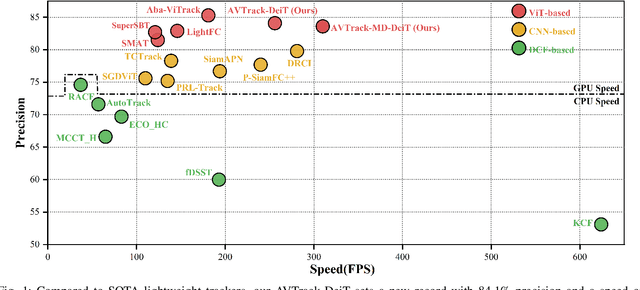
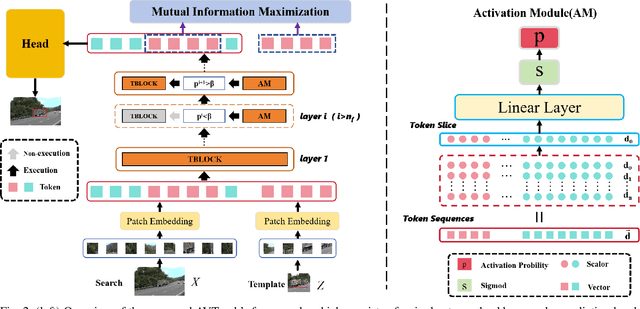
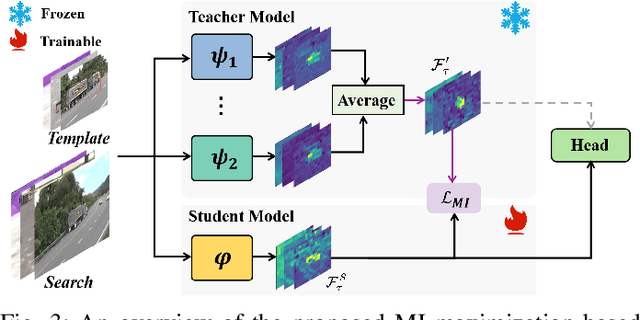
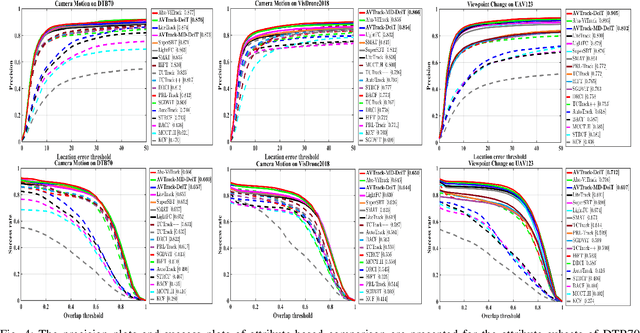
Abstract:Visual tracking has made significant strides due to the adoption of transformer-based models. Most state-of-the-art trackers struggle to meet real-time processing demands on mobile platforms with constrained computing resources, particularly for real-time unmanned aerial vehicle (UAV) tracking. To achieve a better balance between performance and efficiency, we introduce AVTrack, an adaptive computation framework designed to selectively activate transformer blocks for real-time UAV tracking. The proposed Activation Module (AM) dynamically optimizes the ViT architecture by selectively engaging relevant components, thereby enhancing inference efficiency without significant compromise to tracking performance. Furthermore, to tackle the challenges posed by extreme changes in viewing angles often encountered in UAV tracking, the proposed method enhances ViTs' effectiveness by learning view-invariant representations through mutual information (MI) maximization. Two effective design principles are proposed in the AVTrack. Building on it, we propose an improved tracker, dubbed AVTrack-MD, which introduces the novel MI maximization-based multi-teacher knowledge distillation (MD) framework. It harnesses the benefits of multiple teachers, specifically the off-the-shelf tracking models from the AVTrack, by integrating and refining their outputs, thereby guiding the learning process of the compact student network. Specifically, we maximize the MI between the softened feature representations from the multi-teacher models and the student model, leading to improved generalization and performance of the student model, particularly in noisy conditions. Extensive experiments on multiple UAV tracking benchmarks demonstrate that AVTrack-MD not only achieves performance comparable to the AVTrack baseline but also reduces model complexity, resulting in a significant 17\% increase in average tracking speed.
MambaNUT: Nighttime UAV Tracking via Mamba and Adaptive Curriculum Learning
Dec 01, 2024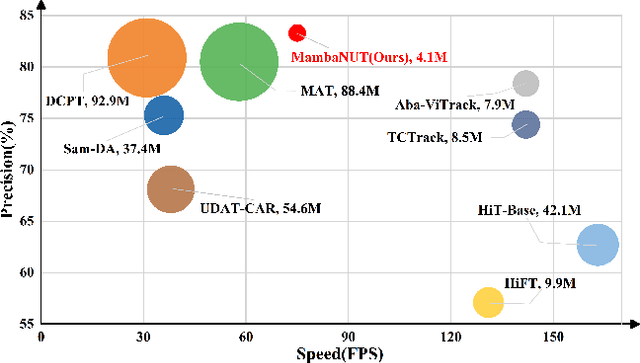
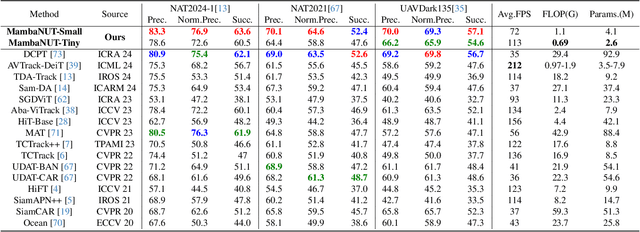
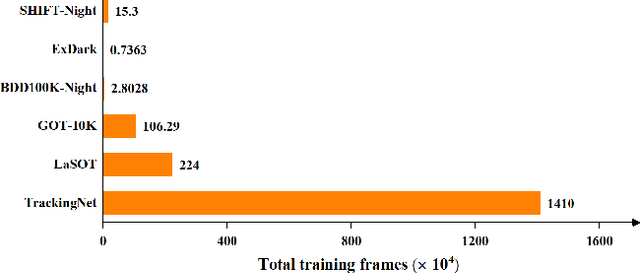

Abstract:Harnessing low-light enhancement and domain adaptation, nighttime UAV tracking has made substantial strides. However, over-reliance on image enhancement, scarcity of high-quality nighttime data, and neglecting the relationship between daytime and nighttime trackers, which hinders the development of an end-to-end trainable framework. Moreover, current CNN-based trackers have limited receptive fields, leading to suboptimal performance, while ViT-based trackers demand heavy computational resources due to their reliance on the self-attention mechanism. In this paper, we propose a novel pure Mamba-based tracking framework (\textbf{MambaNUT}) that employs a state space model with linear complexity as its backbone, incorporating a single-stream architecture that integrates feature learning and template-search coupling within Vision Mamba. We introduce an adaptive curriculum learning (ACL) approach that dynamically adjusts sampling strategies and loss weights, thereby improving the model's ability of generalization. Our ACL is composed of two levels of curriculum schedulers: (1) sampling scheduler that transforms the data distribution from imbalanced to balanced, as well as from easier (daytime) to harder (nighttime) samples; (2) loss scheduler that dynamically assigns weights based on data frequency and the IOU. Exhaustive experiments on multiple nighttime UAV tracking benchmarks demonstrate that the proposed MambaNUT achieves state-of-the-art performance while requiring lower computational costs. The code will be available.
GenUDC: High Quality 3D Mesh Generation with Unsigned Dual Contouring Representation
Oct 23, 2024Abstract:Generating high-quality meshes with complex structures and realistic surfaces is the primary goal of 3D generative models. Existing methods typically employ sequence data or deformable tetrahedral grids for mesh generation. However, sequence-based methods have difficulty producing complex structures with many faces due to memory limits. The deformable tetrahedral grid-based method MeshDiffusion fails to recover realistic surfaces due to the inherent ambiguity in deformable grids. We propose the GenUDC framework to address these challenges by leveraging the Unsigned Dual Contouring (UDC) as the mesh representation. UDC discretizes a mesh in a regular grid and divides it into the face and vertex parts, recovering both complex structures and fine details. As a result, the one-to-one mapping between UDC and mesh resolves the ambiguity problem. In addition, GenUDC adopts a two-stage, coarse-to-fine generative process for 3D mesh generation. It first generates the face part as a rough shape and then the vertex part to craft a detailed shape. Extensive evaluations demonstrate the superiority of UDC as a mesh representation and the favorable performance of GenUDC in mesh generation. The code and trained models are available at https://github.com/TrepangCat/GenUDC.
Low-Resolution Object Recognition with Cross-Resolution Relational Contrastive Distillation
Sep 04, 2024Abstract:Recognizing objects in low-resolution images is a challenging task due to the lack of informative details. Recent studies have shown that knowledge distillation approaches can effectively transfer knowledge from a high-resolution teacher model to a low-resolution student model by aligning cross-resolution representations. However, these approaches still face limitations in adapting to the situation where the recognized objects exhibit significant representation discrepancies between training and testing images. In this study, we propose a cross-resolution relational contrastive distillation approach to facilitate low-resolution object recognition. Our approach enables the student model to mimic the behavior of a well-trained teacher model which delivers high accuracy in identifying high-resolution objects. To extract sufficient knowledge, the student learning is supervised with contrastive relational distillation loss, which preserves the similarities in various relational structures in contrastive representation space. In this manner, the capability of recovering missing details of familiar low-resolution objects can be effectively enhanced, leading to a better knowledge transfer. Extensive experiments on low-resolution object classification and low-resolution face recognition clearly demonstrate the effectiveness and adaptability of our approach.
Learning Privacy-Preserving Student Networks via Discriminative-Generative Distillation
Sep 04, 2024Abstract:While deep models have proved successful in learning rich knowledge from massive well-annotated data, they may pose a privacy leakage risk in practical deployment. It is necessary to find an effective trade-off between high utility and strong privacy. In this work, we propose a discriminative-generative distillation approach to learn privacy-preserving deep models. Our key idea is taking models as bridge to distill knowledge from private data and then transfer it to learn a student network via two streams. First, discriminative stream trains a baseline classifier on private data and an ensemble of teachers on multiple disjoint private subsets, respectively. Then, generative stream takes the classifier as a fixed discriminator and trains a generator in a data-free manner. After that, the generator is used to generate massive synthetic data which are further applied to train a variational autoencoder (VAE). Among these synthetic data, a few of them are fed into the teacher ensemble to query labels via differentially private aggregation, while most of them are embedded to the trained VAE for reconstructing synthetic data. Finally, a semi-supervised student learning is performed to simultaneously handle two tasks: knowledge transfer from the teachers with distillation on few privately labeled synthetic data, and knowledge enhancement with tangent-normal adversarial regularization on many triples of reconstructed synthetic data. In this way, our approach can control query cost over private data and mitigate accuracy degradation in a unified manner, leading to a privacy-preserving student model. Extensive experiments and analysis clearly show the effectiveness of the proposed approach.
Learning Motion Blur Robust Vision Transformers with Dynamic Early Exit for Real-Time UAV Tracking
Jul 07, 2024



Abstract:Recently, the surge in the adoption of single-stream architectures utilizing pre-trained ViT backbones represents a promising advancement in the field of generic visual tracking. By integrating feature extraction and fusion into a cohesive framework, these architectures offer improved performance, efficiency, and robustness. However, there has been limited exploration into optimizing these frameworks for UAV tracking. In this paper, we boost the efficiency of this framework by tailoring it into an adaptive computation framework that dynamically exits Transformer blocks for real-time UAV tracking. The motivation behind this is that tracking tasks with fewer challenges can be adequately addressed using low-level feature representations. Simpler tasks can often be handled with less demanding, lower-level features. This approach allows the model use computational resources more efficiently by focusing on complex tasks and conserving resources for easier ones. Another significant enhancement introduced in this paper is the improved effectiveness of ViTs in handling motion blur, a common issue in UAV tracking caused by the fast movements of either the UAV, the tracked objects, or both. This is achieved by acquiring motion blur robust representations through enforcing invariance in the feature representation of the target with respect to simulated motion blur. The proposed approach is dubbed BDTrack. Extensive experiments conducted on five tracking benchmarks validate the effectiveness and versatility of our approach, establishing it as a cutting-edge solution in real-time UAV tracking. Code is released at: https://github.com/wuyou3474/BDTrack.
 Add to Chrome
Add to Chrome Add to Firefox
Add to Firefox Add to Edge
Add to Edge